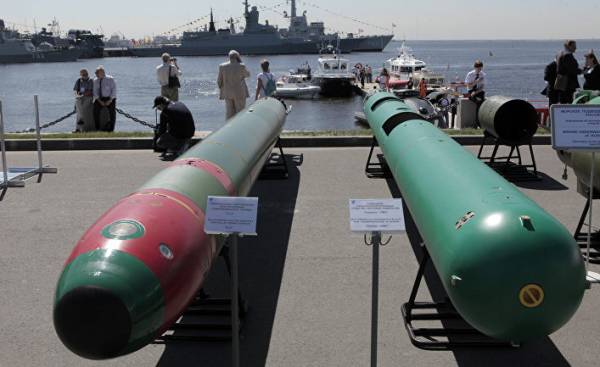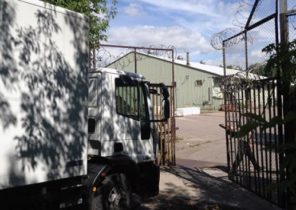
Is there a future for supercavitation torpedoes? The United States is working on this type of weapons since 1997, but is still not ready for placement of samples. In fact, the United States is currently engaged in modernization of a decent respect for the Mark 48 torpedo, placed on submarines. And this is done in order to ensure its use in the foreseeable future. But I should say that the requirements of the manual of the naval forces was much higher than the possibility of a torpedo “Squall”, including turns, identification and elimination of the target.
Meanwhile, the Russian submarines are unique in the world, supercavitational equipped with torpedoes, which is a modernized version of the “Flurry” with a conventional warhead. Russian industry also offers an export version of the torpedo “Squall” to the sale of foreign States. Iran declares that it has its own supercavitational torpedo called Hoot, which, apparently, are the result of applying methods of reverse engineering in respect of a torpedo “Squall”.
In 2004, the German defense contractor Diel-BGT announced the creation of a torpedo Barracuda. We are talking about intended for technology demonstration torpedo, capable of speeds up to 194 knots. Barracuda was intended for launch from submarines and surface ships, and the test model could move both on straight and on curved course. However, this program obviously was never brought to the level of marketable weapons.
Imagine the sudden appearance of the weapon, which has a speed six times greater than the speed of their predecessors. The shock of the emergence of this breakthrough system will put on the head of the whole complex of warfare, while potential adversaries will try something to counter this weapon, but if used they will be defenseless. Although a temporary lull in great power rivalry postponed the impact of this new technology, currently the so-called “supercavitation torpedoes” (supercavitating torpedo), possibly preparing to storm and take over the world.
During the cold war, the Soviet Union largely relied on its submarine fleet in order to compensate for the advantage of America in the Navy. Naval forces of the United States was intended not only to help protect the transport of troops and equipment in Europe if the third world war. They directly threatened the Soviet Union, and, in addition, assumed their part in detecting and destroying Soviet submarines with ballistic missiles on Board. Initially, the Soviet Union used only a large number of diesel-electric submarines, and then in his arms there was a modern attack nuclear submarines that have thwarted the advantage of the enemy.
The most innovative underwater weapon developed by the Soviet Union, became supercavitational torpedo VA-111 “Squall”. It was quite a secret weapon, nothing about it was known before the end of the cold war, and information about the “Shkval” torpedo became available only in mid-1990-ies. The “Shkval” torpedo equipped with a rocket engine, and was able to develop amazing speed — up to 200 nodes per hour. We live in a world where the laws of physics allow the majority of ships and underwater weapons to reach a speed of 50 knots. But, in this case, Russian engineers managed to make such a breakthrough in the field of speed?
Usually torpedoes are used propellers or water-jet thrusters for its delivery to the target. But in the “Shkval” torpedo is mounted a rocket engine. This is enough to make her fast, but the motion of the water creates a significant braking effect. The solution is to remove the water from the path of movement of the torpedo. But how to remove water from the path of the object in the depths of the ocean?
And the output like this — to turn liquid water into gas.
The torpedo Barrage solves this problem by directing hot exhaust from the rocket engine in place of its nose, and the result is placed ahead of her the water turns to steam. As you move forward torpedo continues to turn water into steam in front of him, and this creates a gas bubble. Moving in the gas medium, the torpedo collides with a significantly less resistance, which allows it to reach speeds of up to 200 nodes. This process is called supercavitating.
The trick with supercavitation is that the torpedo is always in gas-filled bladder. This complicates the execution of the maneuver, because the change of direction causes the portion of the torpedo to come out of the bubble, and the result is a resistance on the speed of 370 kilometers per hour. The original version of “Squall”, apparently, had a very primitive system of governance and the attack was used fairly straight direction to launch a torpedo. The warhead of this torpedo can be nuclear, and that would probably be enough to destroy the target. Experts in the Soviet Union apparently believed that in some situations, the speed of a torpedo is much more important than maneuverability.
Torpedo “Squall” was originally developed in 1960-ies as a means for fast attack nuclear submarines NATO, and they were able to deliver a nuclear warhead with previously considered incredible speed. “Squall” — a standard torpedo with a diameter of 533 mm, and the weight of its warhead is about 200 kg. Maximum range of 7 kilometers. Mass production of torpedoes “Squall” began in 1978, and in the same year they entered service with the Soviet Navy.
In torpedo “Squall” as any other weapon, has its shortcomings. First of all, the gas bubble and the rocket engine are very noisy. Any submarine that launches a torpedo supercavitation, instantly gives your approximate location. However, with such speed the torpedo will most likely be able to destroy the enemy, and he simply will not have time to use this information, as this enemy will have to simultaneously deal with the enemy submarine and torpedo, moving at a speed of 200 knots per hour.
Another drawback supercavitating torpedoes is that it is impossible to install a traditional system of governance. Gas bubble and rocket engine create enough noise to drown out the torpedo mounted active and passive sonar system of governance. Earlier versions of the torpedoes “Squall” was probably unmanaged, and management in them was sacrificed for speed. New versions of this torpedo used a compromise method — first used supercavitation for quick delivery of torpedoes in the area to find the goal and then the speed is reduced to its detection.
Is there a future for supercavitation torpedoes? The United States is working on this type of weapons since 1997, and is still not yet ready for placement of samples. In fact, the United States is currently engaged in modernization of a decent respect for the Mark 48 torpedo, placed on submarines. And this is done in order to ensure its use in the foreseeable future. But I should say that the requirements of the manual of the naval forces was much higher than the possibility of a torpedo “Squall”, including turns, identification and elimination of the target.
Meanwhile, the Russian submarines are unique in the world, supercavitational equipped with torpedoes — they represent a modernized version of the “Flurry” with a conventional warhead. Russian industry also offers export version of the “Shkval E” for sale to foreign countries. Iran declares that it has its own supercavitational torpedo called Hoot, which, apparently, are the result of applying methods of reverse engineering in respect of a torpedo “Squall”.
In 2004, the German defense contractor Diel-BGT announced the creation of a Barracuda. We are talking about intended for technology demonstration torpedo, capable of speeds up to 194 knots. Barracuda was intended for launch from submarines and surface ships, and the test model could move both on straight and on curved course. However, this program obviously was never brought to the level of marketable weapons.
The “Shkval” torpedo is noisy, but effective weapon, it breaks the usual paradigm of warfare under water. A torpedo with a speed of 200 knots is a very attractive opportunity, and as increased naval rivalry in the Atlantic and in the Pacific we might see more fleets using torpedoes supercavitation and adapts them for its underwater tactics. Fighting under water will soon become far more noisy and far more deadly.







